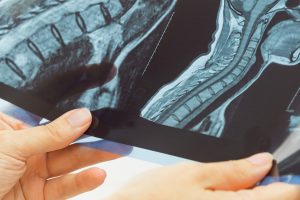
Free Consultation(203) 447-0000

Free Consultation(203) 447-0000

A durotomy is a tear in the dura mater, which is the outer membrane of the spinal cord. The risk of a durotomy is present with most spinal surgeries, but surgeons can typically repair durotomies without long-term consequences for the patient.
However, if a surgeon fails to detect a durotomy, the resultant failure to treat the durotomy can have serious effects. As reported in the medical research journal Spine, “[a]lthough most intraoperative [durotomies] are repaired without sequelae, persistent Cerebrospinal Fluid leak, infection, or neurological injury can yield adverse outcomes.” Sequelae are injuries caused by a previous injury, illness, disorder, or treatment.
Generally speaking, durotomies during spinal surgery are not indicative of medical malpractice. Durotomies are considered to be a “common occurrence in spinal surgery,” and the occurrence of a durotomy is not necessarily indicative of a breach of surgeons’ duty of care.
But, when a surgeon fails to diagnose or adequately repair a durotomy, a claim for medical malpractice may arise. While the Spine study discussed above notes that most medical malpractice claims involving durotomies are resolved in the surgeon’s favor, a Wolters Kluwer article discussing the research notes that “certain types of durotomy cases are more likely to be resolved in favor of the patient—especially when durotomy is detected late or causes more-severe injury.”
Specifically, the article highlights three scenarios in which patients are more likely to prevail in durotomy medical malpractice cases:
Failure to Diagnose the Patient’s Durotomy – Failure to diagnose is not just among the most common grounds for successful durotomy medical malpractice claims. It is among the most common grounds for successful medical malpractice claims generally. If a surgeon fails to diagnose a durotomy (and fails to repair the durotomy as a result), this will often establish a clear right to financial compensation for the patient.
Durotomy Resulting in Severe Neurological Injury – Durotomies resulting in severe neurological injuries are more likely to result in favorable outcomes for patients in medical malpractice litigation than those resulting in minor injuries. This is also true of medical malpractice claims generally. Two examples of severe conditions resulting from durotomies that may support claims for medical malpractice include epidural hematomas and hemorrhagic strokes.
Reopening of the Durotomy Following Repair – Surgical errors resulting in durotomies reopening following repair can also support medical malpractice claims. If a durotomy reopens following repair, this can have the same adverse consequences as failing to diagnose (and failing to repair) the patient’s injury.
In order to seek compensation for a durotomy after spinal surgery, it is necessary to prove that complications from the durotomy are the result of medical malpractice. Simply experiencing complications is not enough on its own—although complications will point toward medical malpractice in many cases.
How can a patient prove that his or her surgeon failed to diagnose or properly treat a durotomy during spinal surgery? Some of the primary forms of evidence used to establish claims for medical malpractice (and examples of how they can be used in durotomy malpractice cases) include:
Medical Records from the Spinal Surgery – If your medical records show that your surgeon attempted to repair your durotomy, but you are still experiencing complications, this can help to establish that the repair was not performed correctly.
Medical Examination Following Spinal Surgery – If you are experiencing symptoms consistent with complications from a durotomy following spinal surgery, a medical examination can confirm that you are suffering from a condition that could (and should) have been avoided.
Medical Records from Subsequent Procedures or Treatment – If you need another surgery to repair your durotomy, your medical records from this procedure can help to prove your prior surgeon’s malpractice.
Testimony from Medical Experts – Expert testimony is a crucial form of evidence in medical malpractice cases. A surgeon familiar with the standards for diagnosing and repairing durotomies during spinal surgery can testify that you are entitled to financial compensation for medical malpractice.
Filing a medical malpractice claim for complications from a durotomy typically means dealing with the surgeon’s malpractice insurance company. When disputing patients’ claims, insurance companies will assert various defenses, as they will be seeking to avoid liability by all means available.
Frequently, malpractice insurers will argue that patients are not entitled to financial compensation because they “assumed the risk” of complications when they consented to their surgeries. In doing so, they will point to patients’ liability waivers, which they will claim prevent patients from asserting their legal rights.
But, while patients assume certain risks when consenting to treatment, they do not accept the risk that their doctors will commit malpractice. So, while a patient might not have a claim for a durotomy itself, that patient typically will have a claim if his or her durotomy could (and should) have been diagnosed and repaired.
The costs of durotomy complications after spinal surgery can be substantial. According to the Spine study discussed above, the average payment in successful durotomy malpractice claims was $2.8 million in 2016-adjusted dollars.
However, to recover compensation for your surgeon’s mistake, you need to calculate your financial and non-financial losses. This includes the costs of necessary medical care, your inability to work, pain and suffering, and various other forms of non-financial harm. When you engage a lawyer to pursue a durotomy malpractice claim, your lawyer will work with medical and financial experts to calculate your losses. Then your lawyer will use the available evidence to seek just compensation on your behalf.
Do you have a durotomy malpractice claim? To find out, schedule a free, no-obligation consultation at Berkowitz Hanna. Call 203-447-0000 or contact us online to speak with an experienced Connecticut medical malpractice lawyer in confidence as soon as possible.
Berkowitz Hanna
